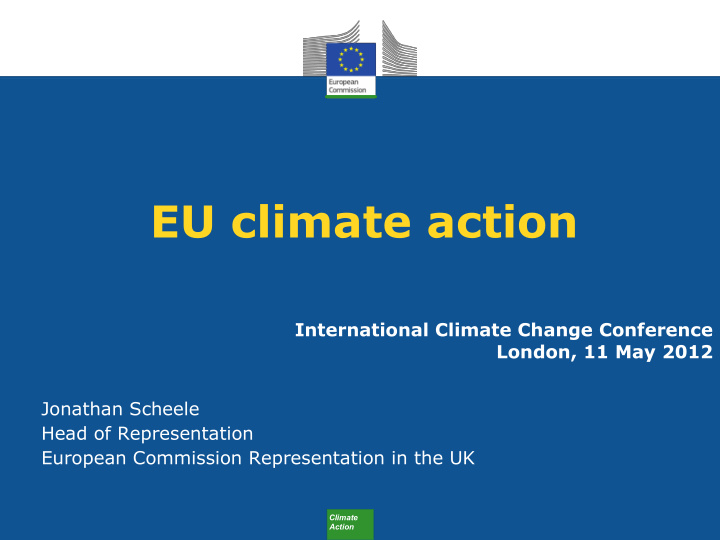



EU climate action International Climate Change Conference London, 11 May 2012 Jonathan Scheele Head of Representation European Commission Representation in the UK Climate Action
O UTLINE ● International climate change policy ● The Durban Conference and next steps ● EU domestic climate change policy ● Getting ready for the next phase 2013 – 2020 ● Planning ahead: EU Roadmap 2050 and next steps ● Conclusions Climate Action
I NTERNATIONAL NEGOTIATIONS T HE D URBAN O UTCOME Implementation ● Kyoto Protocol continues 2 nd Commitment period, LULUCF rules, scope, improved CDM ● Cancun agreements are operational Pledges, Transparency, Climate Technology Center Network, Adaptation Committee, New Market Mechanisms, Green Climate Fund Negotiation ● Durban Platform for Enhanced Action ● Negotiating a new legally binding agreement by 2015 applicable to all countries; ● Right forum to address national circumstances ● Addressing the ambition gap until 2020 Climate Action
I NTERNATIONAL NEGOTIATIONS - N EXT STEPS Implementation ● Kyoto Protocol Commitment Period: Define QELROs, carry-over of AAUs, length of commitment period ● Cancun agreements made operational Progress on implementing pledges, ~ 100 countries without pledges Sources of funding up to 2020 Negotiation ● Durban Platform for Enhanced Action Work plan until 2015, efficiency of negotiation process? Identify additional short-term mitigation action High ambition alliance Climate Action
I NTERNATIONAL CHALLENGE : T HE G AP Climate Action
EU DOMESTIC ACTION – OVERALL FRAMEWORK ● EU to meet Kyoto objectives for 2008-12 ● Enacted legislation to reduce GHG emissions by 20% below 1990 (30% if the conditions are right) ● Amended EU Emissions Trading System ● Effort Sharing Decision: binding national targets ● Renewables Directive: binding national targets ● 2050 EU objective: reducing greenhouse gas emissions by 80-95% by 2050 below 1990, in the context of necessary reductions by developed countries as a group to meet 2 Degree target Climate Action
EU Roadmap(s) to 2050 Part of Europe 2020 Resource Efficiency flagship ● European Council February 2011 ● Need for a low carbon 2050 strategy providing ● certainty: predictability for longer term action Need to fix intermediary milestones (2030, 2040) ● towards reaching the 2050 objective Need to keep developments under regular review ● March 2011: Low carbon roadmap ● Pathway and milestones to -80% domestic by ● 2050 Consistent roadmaps for transport and energy ● Climate Action
EU Low carbon roadmap 2050 - a cost-efficient pathway 80% domestic reduction feasible ● with currently available technologies ● with behavioural change only induced through carbon prices ● If all economic sectors contribute Efficient pathway: -25% in 2020 -40% in 2030 -60% in 2040 Climate Action
Roadmap 2050: Benefits for energy security, air quality, growth and jobs Energy savings and reduction of ● energy imports >30% primary energy savings ● Saving € 400 billion of EU oil ● and gas import bill in 2050 Reduced pollution and health costs ● Shift from fuel costs to investment ● expenditure Investment needs: € 270 billion ● annually 2010-2050 (1.5% of GDP) Innovation in key growth ● sectors crucial for future competitiveness Potential net job creation up to ● Climate 1.5 million by 2020 Action Reduced economic risks from ● climate impacts and oil shocks
EU domestic policy: Next steps (1) Monitoring Mechanism Regulation ● Timely and accurate monitoring of progress in implementation EU Emissions Trading System CO 2 ● Auctioning: mainly for the power (Energy sector, use of auctioning revenue (eg production, NER 300) refineries, industry ● Benchmarking to avoid carbon (steel, leakage in industries at risk cement etc.), ● Inclusion of aviation Aviation); N 2 O (fertilizer) Climate Action
EU domestic policy: Next steps (2) Sectors outside the ETS ● Emission performance standards for cars and light duty vehicles for 2020 ● Common accounting for land CO 2 use, land use change and (Households, forestry Services, Transport), ● Recast of F-gases regulation CH 4 (Waste, ● Energy Efficiency Directive Agriculture), N 2 O (Agriculture) Climate Action
EU domestic policy: Next steps (3) ● Proposal for mainstreaming climate into EU Multiannual Financial Framework 2014-2020 ● Minimum 20% of expenditure climate related ● Structural funds, Cohesion policy ● Common Agricultural Policy ● Research and Innovation ● Transeuropean infrastructure (energy and transport) ● Development cooperation ● Maritime transport ● Adaptation ● New: European Climate Adaptation Platform (CLIMATE-ADAPT) ● Adaptation Strategy in 2013 Climate Action
T OWARDS A 2030 POLICY FRAMEWORK ● Energy Roadmap: next step at EU level is to define 2030 policy framework ● Renewables strategy planned for 2012 ● Presidency conclusions and Parliament response on Low carbon roadmap ● Confirm GHG milestones for 2030 and 2040 ● emphasise EU ETS as key instrument and robust carbon prices as investment incentive ● Invite to present necessary, timely and cost- effective policy proposals for 2030 Climate Action
C ONCLUSIONS ● Credibility of the UNFCCC depends on (i) implementation of pledges under the Cancun agreements, and (ii) on identifying new mitigation initiatives to close the ambition gap by the end of 2013. ● The success of the negotiations under the Durban Platform will hinge on the collective capability to design and implement a new legally binding agreement that is environmentally effective, economically efficient, fair and politically acceptable. ● EU will push ahead on designing and implementing domestic climate policies. EU climate policies demonstrate that, if designed in a smart way, GHG emissions can be reduced while growing the economy in a sustainable and resilient manner. Climate Action
Thank you! http://ec.europa. eu/clima/policies/brief/eu/index_en.htm Climate Action
Recommend
More recommend